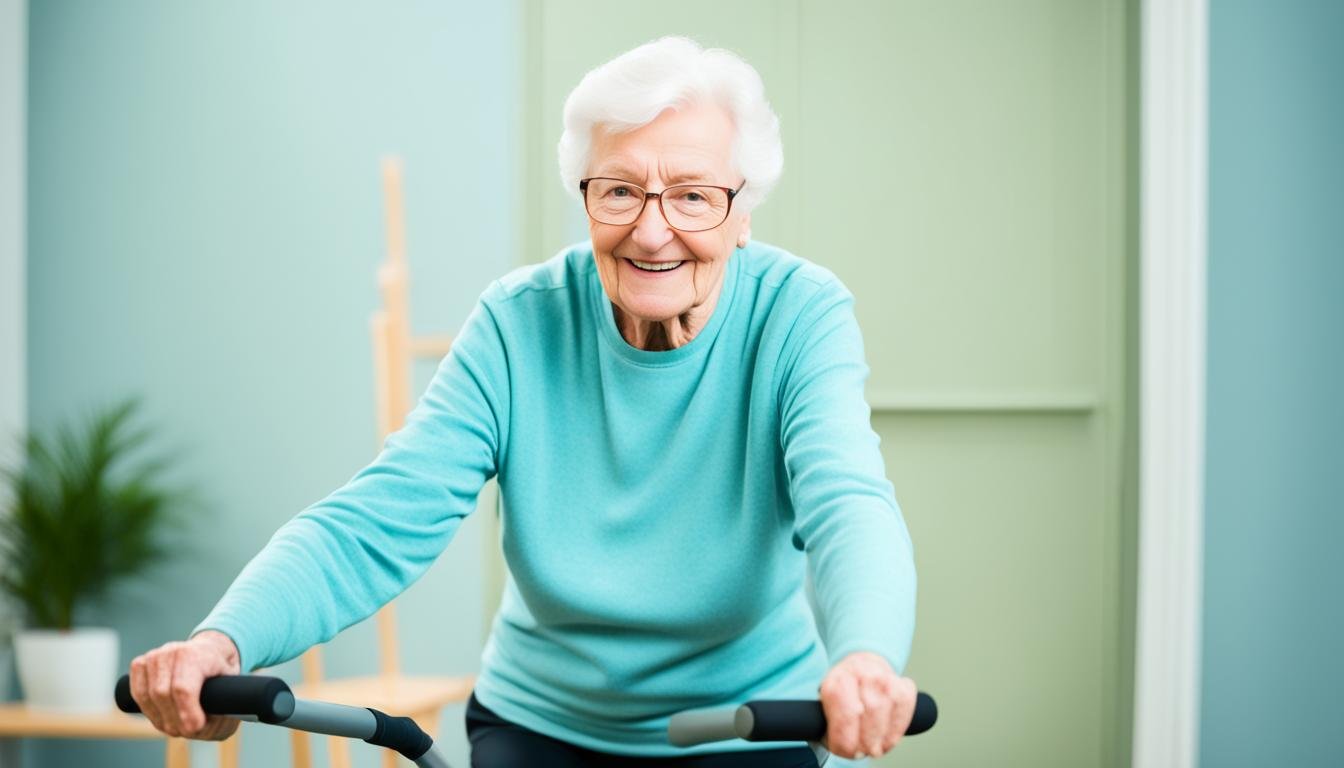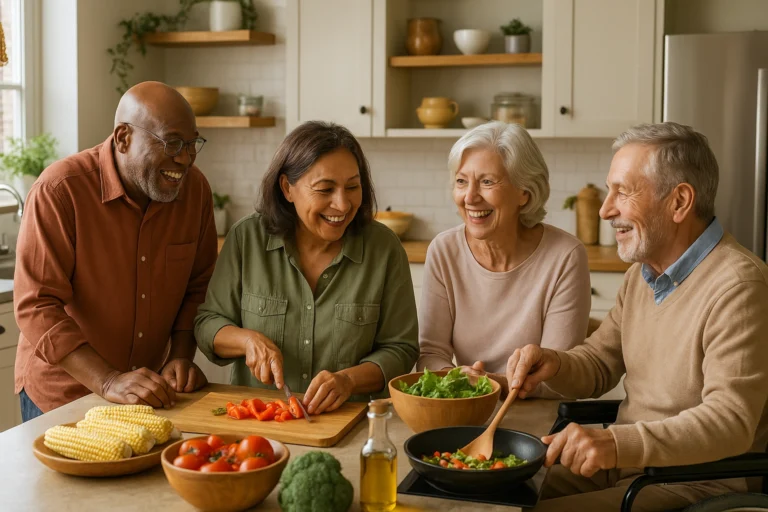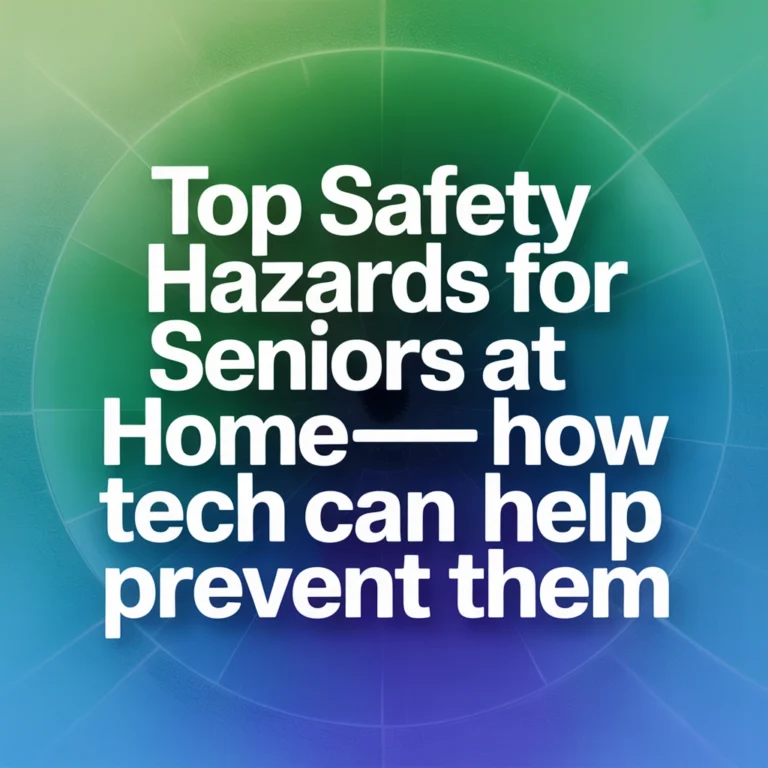As we get older, the chance of falling goes up. This can lead to severe injuries like broken bones. In fact, over one in four people aged 65 or older fall every year. The risk gets even higher as we age. But here’s a fundamental question: Are you aware of the simple steps to reduce the chance of falls and keep your independence?
This guide will provide effective ways to prevent falls and make your living space safer. We’ll discuss checking your medicines, staying active, making your home safer, and using assistive devices. These strategies can help keep you or your loved one safe and independent.
Key Takeaways
- Falls are a big health issue for the elderly, but many can be stopped with proactive steps.
- Checking your medicines, staying active, and improving your home can greatly lower the risk of falling.
- Using assistive devices like canes or walkers can help keep you moving and independent.
- Spotting and fixing fall risk factors is key to a good prevention plan.
- A full plan that includes healthcare providers, caregivers, and the person at risk is essential for successful fall prevention.
Make an Appointment with Your Healthcare Provider
Preventing falls in the elderly begins with a detailed check-up from your healthcare provider. Make an appointment to talk about how to prevent falls. They can give you advice based on your health.
Review Medications
At your visit, be ready to talk about your medicines. Some medicines can make you dizzy or affect your balance, which can lead to falls. Your doctor can look at your medicines and suggest changes if needed.
Discuss Previous Falls
Talk about any falls you’ve had before with your healthcare provider. Tell them when, where, and how the falls happened. This information helps understand what causes falls and how to prevent them.
Evaluate Health Conditions
Your doctor will check your health conditions that might make you more likely to fall, like vision, hearing, or neurological issues. This check-up is key to making a plan to improve your balance and reduce fall risk.
“Regular check-ups with your healthcare provider are essential for identifying and addressing the root causes of falls, ultimately helping you maintain your independence and safety.”
Stay Active and Keep Moving
Staying active is a great way to prevent falls as you get older. With your doctor’s okay, try walking, water exercises, or tai chi. These activities boost your strength, balance, coordination, and flexibility.
If you’re scared to exercise because of falling, tell your doctor. They might suggest supervised programs or a physical therapist to help you feel safe and confident.
Engage in Physical Activities
- Take regular walks, either indoors or outdoors, to improve cardiovascular health and leg strength.
- Try low-impact water exercises, such as swimming or water aerobics, to challenge your balance without the risk of falling.
- Explore gentle balance exercises, like tai chi or yoga, which can enhance your stability and coordination.
Consider Balance and Strength Training
Safe and monitored strength training and balance exercises can lower your fall risk. Work with a healthcare professional to make a program that is safe and effective.
| Exercise | Benefits |
|---|---|
| Squats | Improve lower body strength and balance |
| Lunges | Enhance stability and leg muscle power |
| Heel-to-toe walks | Develop better balance and coordination |
Being active and doing specific exercises can help prevent falls. Talk to your healthcare provider to make a plan that suits you.
Wear Proper Footwear
Choosing the right shoes is key to preventing falls for seniors. Stay away from high heels, loose slippers, and smooth-soled shoes. These can make slipping and falling more likely. Instead, go for shoes that fit well, are strong, and have non-slip soles. Sensible fall-prevention footwear also helps lessen joint pain, which can lead to instability and falls.
When picking shoes with non-slip soles, look for these things:
- Low heels, preferably less than one inch
- Rubber or textured soles for better grip
- A snug fit that supports your feet and ankles
- Good cushioning and arch support
Getting a pair of slip-resistant shoes can greatly improve your balance and stability. This can lower your risk of falls and injuries. By choosing the right footwear, you’re taking a big step towards staying safe and independent as you get older.
“Wearing the right shoes can be a simple yet effective way to prevent falls and promote overall safety for older adults.”
Remove Home Hazards
Making your home safe is key to stopping falls in older adults. Start by finding and removing dangers at home. Look around your house and fix any spots that could lead to a fall.
Clear Walkways and Secure Loose Rugs
First, clear your walkways of things like boxes, cords, or other items that could trip you. Use double-faced tape or non-slip backing to keep rugs in place. If you can, take out area rugs to make paths clear.
Repair Loose Floorboards and Carpets
Check your floors for loose boards or uneven carpets. These can be tripping points, so fix or replace them. Securing your floors helps lower the chance of falls.
Clean up Spills Immediately
Wet or slippery floors often cause falls. Always clean spills quickly. Use non-slip mats or rugs in busy spots for better grip.
By spotting and fixing home hazards, you can make your home safety better and cut down on falls. These easy steps help in fall-proofing your living area.
“Eliminating potential fall hazards in the home is one of the most effective ways to prevent falls among the elderly.”
Improve Lighting in Your Living Space
Good home lighting is key to preventing falls, especially for seniors. Bright lights help you see objects clearly and avoid tripping. Here are some tips to make your home safer:
Install Night Lights
Put night lights in key spots like bedrooms, bathrooms, and hallways. These lights give enough light to help you move safely at night. They’re perfect for bathroom trips or walking through the dark.
Place Lamps Within Reach
Make sure lamps are easy to get to, especially by your bed. This lets you turn them on quickly if you wake up. Using glow-in-the-dark or illuminated light switches makes things even easier.
“Good lighting not only enhances visibility but also promotes psychological well-being, which is crucial for older adults.”
These lighting tips can make your home safer and easier to move around in. They help lower the chance of falls and improve your health.
Use Assistive Devices
As you get older, keeping your mobility and independence is key. Luckily, there are many assistive devices and mobility aids to help you move safely at home. These can prevent falls. Your doctor might suggest using a cane or walker to help with balance and stability.
Home modifications like grab bars and handrails are also very helpful. Make sure to install handrails on both sides of stairs and make them secure. Also, put grab bars in places like the shower, tub, and near the toilet for extra support.
Consider Canes or Walkers
Canes and walkers are great for keeping your balance and lowering fall risks. They give you a stable base, letting you move more easily and with confidence. Your doctor can help pick the best device for you and make sure it fits right.
Install Grab Bars and Handrails
Putting grab bars and handrails in key spots can greatly improve your safety and independence. These home modifications offer the support you need to move around safely. This reduces the chance of falls and injuries.
“Using the right assistive devices can significantly enhance your safety and independence.”
Your comfort and well-being are most important. By adding the right assistive devices and home modifications to your daily life, you can keep moving easily and feel more secure at home.
How to Prevent Falls for Elderly
As we get older, we face a higher risk of falling. It’s important to know what makes falling more likely and how to prevent it. Working with your healthcare provider can help you find the best ways to stay safe and independent.
Identify Risk Factors
Many things can make older adults more likely to fall. These include:
- Certain health conditions, such as vision problems, balance issues, or muscle weakness
- Medication side effects or interactions that can cause dizziness or drowsiness
- Environmental hazards in the home, such as loose rugs, poor lighting, or cluttered walkways
- Decreased physical activity and muscle tone, which can affect balance and stability
Implement Fall Prevention Strategies
After your healthcare provider spots your fall risk factors, you can start taking steps to prevent falls. Here are some ways to stay safe:
- Review your medication list with your doctor to identify any that may increase your fall risk and discuss alternatives or adjustments.
- Engage in regular physical activities, such as balance exercises or strength training, to improve your overall fitness and stability.
- Make necessary home modifications, such as installing grab bars, handrails, and proper lighting, to create a safer living environment.
- Use assistive devices, such as canes or walkers, as recommended by your healthcare provider to aid in mobility and prevent falls.
By taking steps to prevent falls, you can help keep yourself safe and independent as you age.
“The key to preventing falls is to identify and address the underlying risk factors. By working closely with your healthcare team, you can develop a personalized plan to stay safe and active.”
Fall-proofing Your Home: Room by Room
Making your home safe is key to preventing accidents, especially for the elderly. Let’s see how to make each room safer to lower fall risks and keep you independent.
Bathroom Safety
The bathroom can be risky with slippery floors and water around. To make it safer, put grab bars near the toilet, tub, and shower. Use non-slip mats on the floor to stop slips. Think about a raised toilet seat or a chair with armrests for easier getting up and down.
Bedroom Safety
In the bedroom, have night lights and light switches easy to reach to avoid tripping in the dark. Keep a flashlight by your bed for nighttime needs. Make sure your bed is at a good height for easy getting in and out. Clear the room of clutter to avoid tripping.
Kitchen Safety
The kitchen can be tricky with spills, hot surfaces, and reaching for things. Keep things you use often at waist level to avoid bending. Clean spills right away to stop slips. Try making meals while seated to cut down on fatigue and balance risks.
By tackling fall hazards in each room, you can greatly lower your fall risk and keep safe and independent. Remember, being proactive with home safety helps prevent falls and keeps you well.
What to Do If You Fall
Falling is not something we want to happen, but knowing how to react is key. Keeping cool and acting right can stop more harm and get you the help you need.
Stay Calm and Assess the Situation
If you end up on the floor, breathe deeply to stay calm. Check if you’re hurt before trying to stand up. This helps you figure out what to do next.
Get Help If Needed
If you can slowly move to a stable chair or the bed edge, do that. But if you’re hurt or can’t move by yourself, call for help or activate an emergency response. Staying calm and getting help fast can stop more harm and make sure you get the right medical care.
How you react to a fall is crucial for fall response, emergency procedures, and injury prevention. By staying calm and acting right, you can lessen the effects of a fall and get the support you need.
“Remaining calm and getting assistance quickly can help prevent further injury and ensure you receive the appropriate medical attention.”

Conclusion
Falls are a big risk for seniors, but many can be prevented. Working with your healthcare provider, staying active, making home changes, and using assistive devices can lower your risk. This can help you avoid a serious fall.
Preventing falls means tackling many factors that affect balance and mobility. This includes checking your meds, talking about past falls, and doing exercises to improve balance and strength. These steps can help you stay safe and independent as you get older.
Remember, preventing falls is an ongoing effort. It’s about always putting your safety and well-being first. By making these strategies part of your daily life, you can live better, move more easily, and feel secure knowing you’re taking steps to protect your health.
Starting this journey towards a safer, more independent life? Check out the SeniorThrive App. It has tools and resources to help with fall prevention. With personalized advice, reminders, and a supportive community, it could be a big help.
“Preventing falls is not just about avoiding injury, but about maintaining the freedom and confidence to live life on your own terms.”
Your safety and independence are important. By following the steps in this guide, you can lower your risk of falls. This means you can live a more active, happy life. Embrace fall prevention and look forward to a future full of confidence, mobility, and thriving.
Introducing the SeniorThrive App
The SeniorThrive app is a great tool for seniors and their caregivers. It helps prevent falls and keeps you living on your own. The app does personalized fall risk checks, spots dangers at home, and gives advice to make you safer.
This app connects you with a caring community and offers resources for caregivers. It fights against senior isolation. With the SeniorThrive app, you get lots of info and support to stay safe and independent. It’s perfect for seniors wanting to stay mobile or caregivers aiming to give the best care.
Use the SeniorThrive app to take charge of your safety and health. Get personal tips, find useful resources, and join a supportive community. The SeniorThrive app lets you live better and independently, with confidence.
Source Links
- https://www.nia.nih.gov/health/falls-and-falls-prevention/preventing-falls-home-room-room – Preventing Falls at Home: Room by Room
- https://www.nia.nih.gov/health/falls-and-falls-prevention/falls-and-fractures-older-adults-causes-and-prevention – Falls and Fractures in Older Adults: Causes and Prevention
- https://www.mayoclinic.org/healthy-lifestyle/healthy-aging/in-depth/fall-prevention/art-20047358 – Fall prevention: Simple tips to prevent falls



